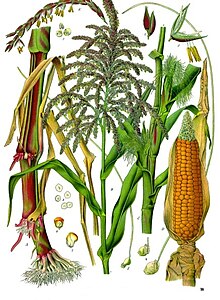Zea Mays
| Maize | |
|---|---|
 |
|
| Illustration depicting both male and female flowers of maize | |
| Scientific classification | |
| Kingdom: | Plantae |
| (unranked): | Angiosperms |
| (unranked): | Monocots |
| (unranked): | Commelinids |
| Order: | Poales |
| Family: | Poaceae |
| Subfamily: | Panicoideae |
| Tribe: | Andropogoneae |
| Genus: | Zea |
| Species: | Z. mays |
| Subspecies: | Z. mays subsp. mays |
| Trinomial name | |
|
Zea mays subsp. mays L. |
|
| Nutritional value per 100 g (3.5 oz) | |
|---|---|
| Energy | 360 kJ (86 kcal) |
|
18.7 g
|
|
| Starch | 5.7 g |
| Sugars | 6.26 g |
| Dietary fiber | 2 g |
|
1.35 g
|
|
|
3.27 g
|
|
| Tryptophan | 0.023 g |
| Threonine | 0.129 g |
| Isoleucine | 0.129 g |
| Leucine | 0.348 g |
| Lysine | 0.137 g |
| Methionine | 0.067 g |
| Cystine | 0.026 g |
| Phenylalanine | 0.150 g |
| Tyrosine | 0.123 g |
| Valine | 0.185 g |
| Arginine | 0.131 g |
| Histidine | 0.089 g |
| Alanine | 0.295 g |
| Aspartic acid | 0.244 g |
| Glutamic acid | 0.636 g |
| Glycine | 0.127 g |
| Proline | 0.292 g |
| Serine | 0.153 g |
| Vitamins | |
| Vitamin A equiv. |
(1%)
9 μg
644 μg
|
| Thiamine (B1) |
(13%)
0.155 mg |
| Riboflavin (B2) |
(5%)
0.055 mg |
| Niacin (B3) |
(12%)
1.77 mg |
| Pantothenic acid (B5) |
(14%)
0.717 mg |
| Vitamin B6 |
(7%)
0.093 mg |
| Folate (B9) |
(11%)
42 μg |
| Vitamin C |
(8%)
6.8 mg |
| Minerals | |
| Iron |
(4%)
0.52 mg |
| Magnesium |
(10%)
37 mg |
| Manganese |
(8%)
0.163 mg |
| Phosphorus |
(13%)
89 mg |
| Potassium |
(6%)
270 mg |
| Zinc |
(5%)
0.46 mg |
| Other constituents | |
| Water | 75.96 g |
|
Link to USDA Database entry
One ear of medium size (6-3/4" to 7-1/2" long) maize has 90 grams of seeds |
|
|
|
| Percentages are roughly approximated using US recommendations for adults. Source: USDA Nutrient Database |
|
Maize (/ˈmeɪz/ MAYZ; Zea mays subsp. mays, from Spanish: maíz after Taíno mahiz), also known as corn, is a large grain plant first domesticated by indigenous peoples in Mexico about 10,000 years ago. The six major types of corn are dent corn, flint corn, pod corn, popcorn, flour corn, and sweet corn.
The leafy stalk of the plant produces separate pollen and ovuliferous inflorescences or ears, which are fruits, yielding kernels (often erroneously called seeds). Maize kernels are often used in cooking as a starch.
Most historians believe maize was domesticated in the Tehuacan Valley of Mexico. Recent research modified this view somewhat; scholars now indicate the adjacent Balsas River Valley of south-central Mexico as the center of domestication.
The Olmec and Mayans cultivated maize in numerous varieties throughout Mesoamerica, cooked, ground or processed through nixtamalization. It's believed that beginning about 2500 BC, the crop spread through much of the Americas. The region developed a trade network based on surplus and varieties of maize crops. Nevertheless, recent data indicates that the spread of maize took place even earlier. According to Piperno,
...
Wikipedia
